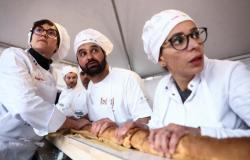In the past, it was often kept silent about it. In the hospital, doctors whispered when an intersex child was born, someone with male and female sexual characteristics, hormones or chromosomes. Was it a boy or a girl? Parents were asked to make a choice and raise the child accordingly. The dilemma was then covered up, under the guise of: if you don’t talk about it, it doesn’t exist. Hurtful for the people involved and not just because the ‘wrong’ choice was sometimes made or because someone later noticed that they felt like a man and a woman. Because how bad must it be to spend your entire life feeling like you can’t be honest about who you are? Fortunately, this has changed a lot in recent years. In the medical world there is more room for different choices and intersex people are increasingly speaking out and showing who they are. Like presenter/musician Raven van Dorst in 2017. In her own program Gender! she says, “I’m what they call ‘a true hermaphrodite’. On doctor’s advice, it was previously decided to make me a girl, through hormones and operations. But now I no longer care about the expectations of others. Sometimes I do something that is associated with women, other times something that is called masculine. It’s not all that black and white.”
Biology lesson
Intersex is a variation in biological sex: you have people who were born male, female or intersex. So it is different from sexual preference (gay, straight, bisexual) or gender identity: someone who was born one gender, but feels like the other gender. To make it just a little more complicated: there are endless variations. For example, intersex people have hormones that deviate from the norm (much or little estrogen and testosterone), or this is the case with their gonads (yes, none or both ovaries and testes), body hair, breast development or reproductive organs. There are people with a micropenis, women who are born without a uterus and many more variants. In short: one intersex person is not the same as the other. About 190,000 Dutch people fall under this heading. Miriam van der Have is director of NNID, the only Dutch organization for gender diversity, and has been committed to the human rights of intersex people for decades. “I have already seen a lot of improvements. Fortunately, it is rarely concealed from intersex people what exactly is going on. But there is still plenty to gain. For example, it is often said that it is better not to tell anyone, because others would not understand. As a result, many intersex people suffer from shame and a feeling of inferiority. This can have major consequences, such as psychological problems. We saw this earlier with the openness surrounding homosexuality and among trans people: the more they realized that they were allowed to be there, just like everyone else, the better they fared mentally.”
Hormones and surgery
In the medical world, the term Disorders of Sex Development (DSD) often appears, while organizations such as the NNID mainly use intersex (or Differences of Sex Development), because they believe the term disorder – disease/condition – is unjustified. Until 2003, secrecy was an important part of how the medical world dealt with it. Although things are improving, it still happens that doctors adapt the bodies of intersex children to the standard image of a boy or girl’s body through hormone treatments and operations.
Miriam: “Intersex is not dangerous, does not hurt and cannot be cured. It is harmful to implement such treatments without people having a say in them. Some intersex people may develop problems with, for example, the heart and kidneys or osteoporosis, so it is logical for doctors to focus on these. But adapting someone’s body to the norm is something different and often unnecessary.” The choice for male or female can therefore be made at a young age by parents, often strongly advised by doctors. “You can choose to call someone a boy or a girl, if the child in question feels comfortable with that. But why operate immediately? Trans children must be at least 18 years old for this, but for intersex children that choice is sometimes made for them as a baby. Even if you have a great life in the gender that has been chosen for you, it is nice if you have been able to make that choice yourself at a time when it feels good for you.”

Intersex discrimination
Even when intersex people are satisfied with the gender they portray to the outside world, they can still struggle with the fact. For example, out of insecurity (do I look feminine enough?), because they want to have children that is not possible or because sex is more difficult for them according to the standard image. It’s quite something to learn to deal with. In 2020, a study was published by the Fundamental Rights Agency, part of the EU. This included the experiences of intersex people for the first time. It turned out that more than 1 in 3 feels discriminated against. In addition, they experience poverty more than average. Eurobarometer (2019) showed that people think intersex people are the least discriminated against among the LGBTQIA+ community. But in practice, 86 percent of Dutch people say they accept it if their child has a relationship with someone of the same sex, while only 68 percent accept it if it concerns an intersex person. Ghent University Hospital and the Dutch expertise center for sexuality Rutgers discovered that when people know more about intersex, they develop a more positive attitude towards this group. The more knowledge we have about intersex (and gender diversity in general), the less we think in boxes and the more room there is for people who do not fit the average picture one hundred percent.

Better visible
In 2003, people who called themselves intersex were on television for the first time, during the program Vinger aan de pols. One of them was Miriam from the NNID itself: “I was in my early forties and had my own company. Many people strongly advised against it, what would my customers and employees think about me? I did it anyway, because I didn’t want to hide anymore. Fortunately, I only received positive reactions. But while there is now more and more openness about transgender people, for example, the sharing of stories about intersex people is still lagging behind.” A great step in this area is the 1 in 90 project by the Open Mind Foundation, a traveling exhibition and magazine in which intersex people were portrayed. The varied stories and photos clearly show that there is a lot of diversity in experiences. The NNID also participates in Canal Pride in Utrecht and the United Nations has issued advice to the Netherlands, including to stop unnecessary medical treatments (particularly assigning a certain sex at a young age). Miriam: “Intersex people have always existed: you can even read about gender diversity in the Bible. This group of people was only kept quiet. Society is changing in that area, little by little, and that’s a good thing. Because whoever or whatever you are, you can be there. No one has to hide.”

Ellen van der Velden (53): “I have androgen insensitivity syndrome (AOS, ed.). This means that you are born as a man, but your body is insensitive to testosterone, so you eventually develop female sexual characteristics and also look like one. Many intersex people have been told for years that it was better to keep quiet about it, that no one would understand. Me, too. This is how the shame surrounding it perpetuates itself. Fortunately, there has been more openness about this in recent years. I was about three months old when all kinds of tests were done in the hospital and my parents were informed what was wrong with me. Fortunately, they never kept that from me. In a fetus, certain tissue develops into ovaries or testes, but for me it remained a bit unclear between the two. When I was nine months old, they removed that tissue. As a child, I once asked my mother if I would have children when I grew up. Her answer was matter-of-fact: “Some women have children, some don’t, and you fall into the second group.” I shrugged and continued playing, it didn’t really bother me. That didn’t happen until I was about ten. My mother was my greatest role model. Her life revolved around that of her family and I suddenly realized: if I am biologically different, then that is not an option for me. I would have to organize my life differently.”

Good enough
“I now have a nice job and I’m doing really well, but it took a lot of effort. For a long time it felt as if a part of myself was not allowed to exist. I felt ashamed and translated it in my head as: I’m not good enough. That’s why it felt safer to keep it quiet. I’ve always had friends, but it took me a long time to discuss the fact that I was intersex with them. I became very adept at avoiding conversations about menstruation and pregnancy, also out of fear. Because they may have been friends with me, but if they had known what I was really like, they probably wouldn’t have been. That thought was stuck in my head. Until the Pride Walk in 2017, in Amsterdam. I walked on behalf of Doctors Without Borders, as a sympathizer with the LGBTIQ+ community. That’s where I first heard the term intersex, which is the ‘i’ in this abbreviation. Wait a minute, I thought then. This is just about me. It made a lot of sense. For so long I thought I was a failed woman. Ever since I came across the term intersex, I have known that it is nothing more or nothing less than a variation in gender. There are a lot of them, and they’re all okay. There is nothing wrong with me, I have no syndrome or abnormality, my body is just constructed a little differently than most bodies. That change in thought made me dare to tell more people. And guess what? No one thought I was weird, no friend turned away from me. What I was so afraid of all those years never happened.”











